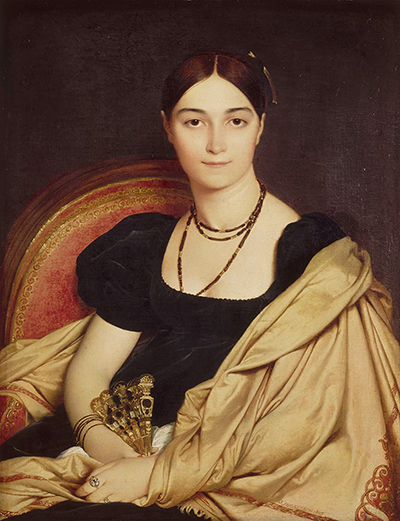Madame Antonia Duvaucey of Nittis was the lover of Charles-Jean-Marie Alquier, ambassador to the Holy See, and she was painted by Ingres at the Académie de France in Rome. She looks out from a flat background in what the first portrait of a woman that Ingres had completed. The half-length view shows her with hair in a middle-parting.
Wearing expensive garments and jewellery, and seated in a Louis XVI chair, she carries a fine-looking fan. Ingres had a talent for portraying feminine style, and he captures here the simplicity of this tasteful high-waisted black dress with short sleeves, contrasted with a lush drape over one shoulder. The perspective seems a little strange, however, with one arm appearing to be longer than the other, but these distortions of space and form put him ahead of his time, and were to influence pioneers in modern art, such as Picasso and Matisse.
The picture was exhibited at the Salon in 1833 and 1855, and was well received by most critics. Today, it is considered as a landmark in portraiture, and is one of the artist's best-known works. Forty years after sitting for the portrait, financial circumstances led Madame Duvaucey to seek to sell the picture, and she visited Ingres in Paris, where he was now director of the Académie Française. He found a buyer, Fredric Reisit, whose collection eventually became the Musée Condé, Chantilly. The painting of Madame Duvaucey by Jean-Auguste-Dominique Ingres can still be seen there today.
Jean-Auguste-Dominique Ingres was a French Neoclassical painter, who sought to maintain academic orthodoxy against the coming Romantic style of painters such as Delacroix. He was influenced by Jacques-Louis David and Nicolas Pousain, and considered himself to be, like them, a painter of history. He looked back to the time of Raphael, which he considered a "century of glorious memory", but this is not how he is judged today. Indeed, it was the influence of Italian painting, picked up while he was in Rome, where he painted Madame Duvaucey, that developed his interest in portraiture.
He styled himself as a conservator of the status quo, but he is now ironically thought of as part of the Romantic movement of the era, together with the other Neoclassicists. Today, his portraits are considered to be his best work, and this oil-on-canvas portrayal of Madame Duvaucey in 1807 shows a personable young woman in a typical rendition by Ingres. Having been a student at the Ecole des Beaux-Arts in Paris, in 1801 Ingres was awarded a scholarship to Rome. Following an unfavourable reception at the Salon in Paris, he decided to accept the scholarship in 1806, and hence was available to take up the commission to make a portrait of Madam Duvaucey in Rome.




